Hippolyte's Belt
Hercules Fights the Amazons
For the ninth labor, Eurystheus ordered Hercules to bring him the belt of Hippolyte [Hip-POLLY-tee]. This was no ordinary belt and no ordinary warrior. Hippolyte was queen of the Amazons, a tribe of women warriors.
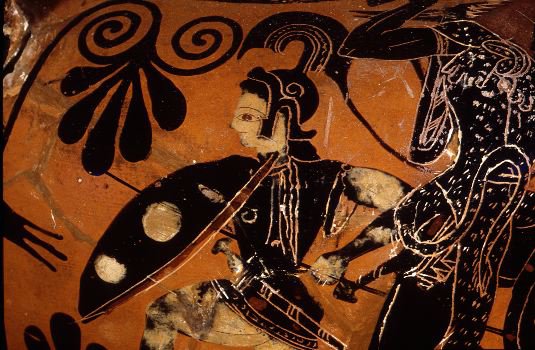
Mississippi 1977.3.57, Attic black figure neck amphora, c. 530-520 B.C.
Side A: Amazon on left, detail
Photograph by Maria Daniels, courtesy of the University Museums, University of Mississippi
These Amazons had nothing to do with the Amazon river in South America. Their name comes from a Greek word meaning "missing one breast." This is because an Amazon's right breast got in the way when she threw a spear.
The Amazons lived apart from men, and if they ever gave birth to children, they kept only the females and reared them to be warriors like themselves.
Queen Hippolyte had a special piece of armor. It was a leather belt that had been given to her by Ares, the war god, because she was the best warrior of all the Amazons. She wore this belt across her chest and used it to carry her sword and spear. Eurystheus wanted Hippolyte's belt as a present to give to his daughter, and he sent Hercules to bring it back.
Hercules' friends realized that the hero could not fight against the whole Amazon army by himself, so they joined with him and set sail in a single ship.
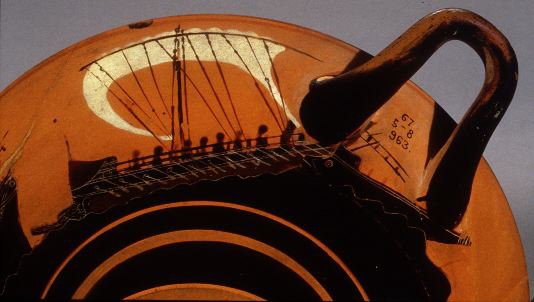
London B 436, Attic black figure kylix, c. 540-500 B.C.
A warship with mast and sail. Its prow is in the form of a boar's head, and it has a high fore-deck, steering oars and a landing ladder at the stern. Eight figures can be seen rowing the upper set of oars (there are at least as many people on the lower deck) and the sail is fully extended, giving the impression that the boat is moving "full speed ahead."
Photograph courtesy of the Trustees of the British Museum, London
After a long journey, they reached the land of the Amazons and put in at the harbor. When Hercules and the Greeks got off the boat, Hippolyte came down to visit them.
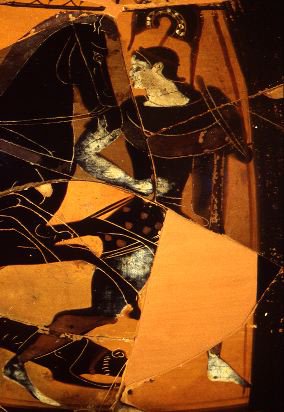
Philadelphia MS4832, Attic black figure amphora, c. 525-500 B.C.
Amazon running, with her dog along side.
Photograph by Maria Daniels, courtesy of The University of Pennsylvania Museum
She asked Hercules why he had come, and when he told her, she promised to give him the belt. But the goddess Hera knew that the arrival of Hercules meant nothing but trouble for the Amazons. Disguised as an Amazon warrior, Hera went up and down the army saying to each woman that the strangers who had arrived were going to carry off the queen. So the Amazons put on their armor.
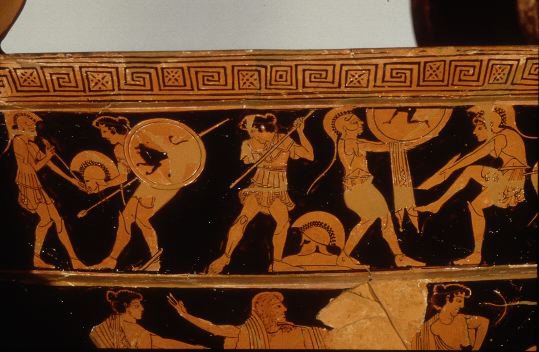
Malibu 77.AE.11, Attic red figure volute krater, c. 490 B.C.
Amazons arming.
Collection of the J. Paul Getty Museum, Malibu, California
The women warriors charged on horseback down to the ship.
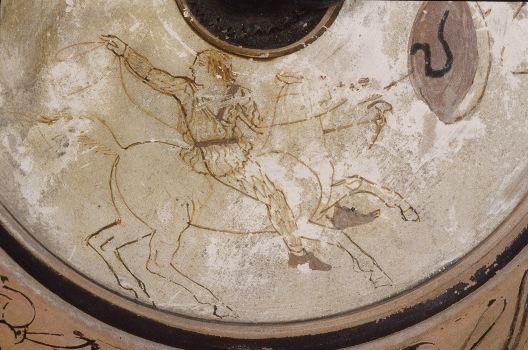
Mississippi 1977.3.243, Attic red figure white ground pyxis, c. 460-450 B.C.
Amazon on horseback.
Collection of the J. Paul Getty Museum, Malibu, California
But when Hercules saw that they were wearing their armor and were carrying their weapons, he knew that he was under attack. Thinking fast, he drew his sword and killed Hippolyte.
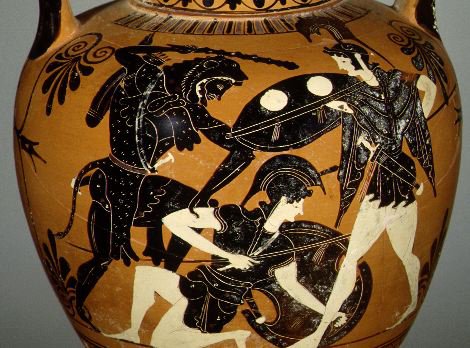
Tampa 82.11.1, Attic black figure neck amphora, c. 510-500 B.C.
Hercules battles the Amazons. The Amazon has fallen to one knee, supported by the shield on her left arm. A wrapped object at her waist may represent the prized belt.
Collection of the J. Paul Getty Museum, Malibu, California
Then he undid her belt and took it away from her.
Hercules and the Greeks fought the rest of the Amazons in a great battle.
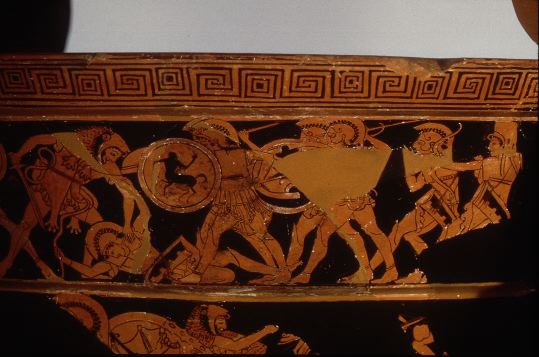
Malibu 77.AE.11, Attic red figure volute krater, c. 490 B.C.
Hercules fighting the Amazons.
Collection of the J. Paul Getty Museum, Malibu, California
When the enemy had been driven off, Hercules sailed away. After a stopover at the city of Troy, Hercules returned to Mycenae, and he gave the belt to Eurystheus.
(wpm)
To read more about these topics, see Further Resources.
- Labor 1: The Nemean Lion
- Labor 2: The Lernean Hydra
- Labor 3: The Hind of Ceryneia
- Labor 4: The Erymanthean Boar
- Labor 5: The Augean Stables
- Labor 6: The Stymphalian Birds
- Labor 7: The Cretan Bull
- Labor 8: The Horses of Diomedes
- Labor 9: The Belt of Hippolyte
- Labor 10: Geryon's Cattle
- Labor 11: The Apples of the Hesperides
- Labor 12: Cerberus
This exhibit is a subset of materials from the Perseus Project digital library and is copyrighted. Please send us your comments.